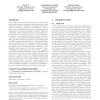476 search results - page 63 / 96 » Computing the Capacity Region of a Wireless Network |
ADHOCNOW
2010
Springer
13 years 10 months ago
2010
Springer
Random walks in wireless sensor networks can serve as fully local, very simple strategies for sink motion that reduce energy dissipation a lot but increase the latency of data coll...
MOBIHOC
2001
ACM
14 years 8 months ago
2001
ACM
Spatial reuse TDMA is a fixed assignment access scheme for multi-hop radio networks. The idea is to increase network capacity by letting several radio terminals use the same time ...
MOBIHOC
2008
ACM
14 years 8 months ago
2008
ACM
It has been an important research topic since 1992 to maximize stability region in constrained queueing systems, which includes the study of scheduling over wireless ad hoc networ...
WIOPT
2006
IEEE
14 years 3 months ago
2006
IEEE
— In this paper we investigate the limiting properties, in terms of capacity and delay, of an ad hoc network employing a topology-transparent scheduling scheme. In particular, we...
ADHOCNOW
2004
Springer
14 years 2 months ago
2004
Springer
Sensor networks consist of multiple low-cost, autonomous, ad-hoc sensors, that periodically probe and react to the environment and communicate with other sensors or devices. A prim...

